
 Skip to content
Skip to content
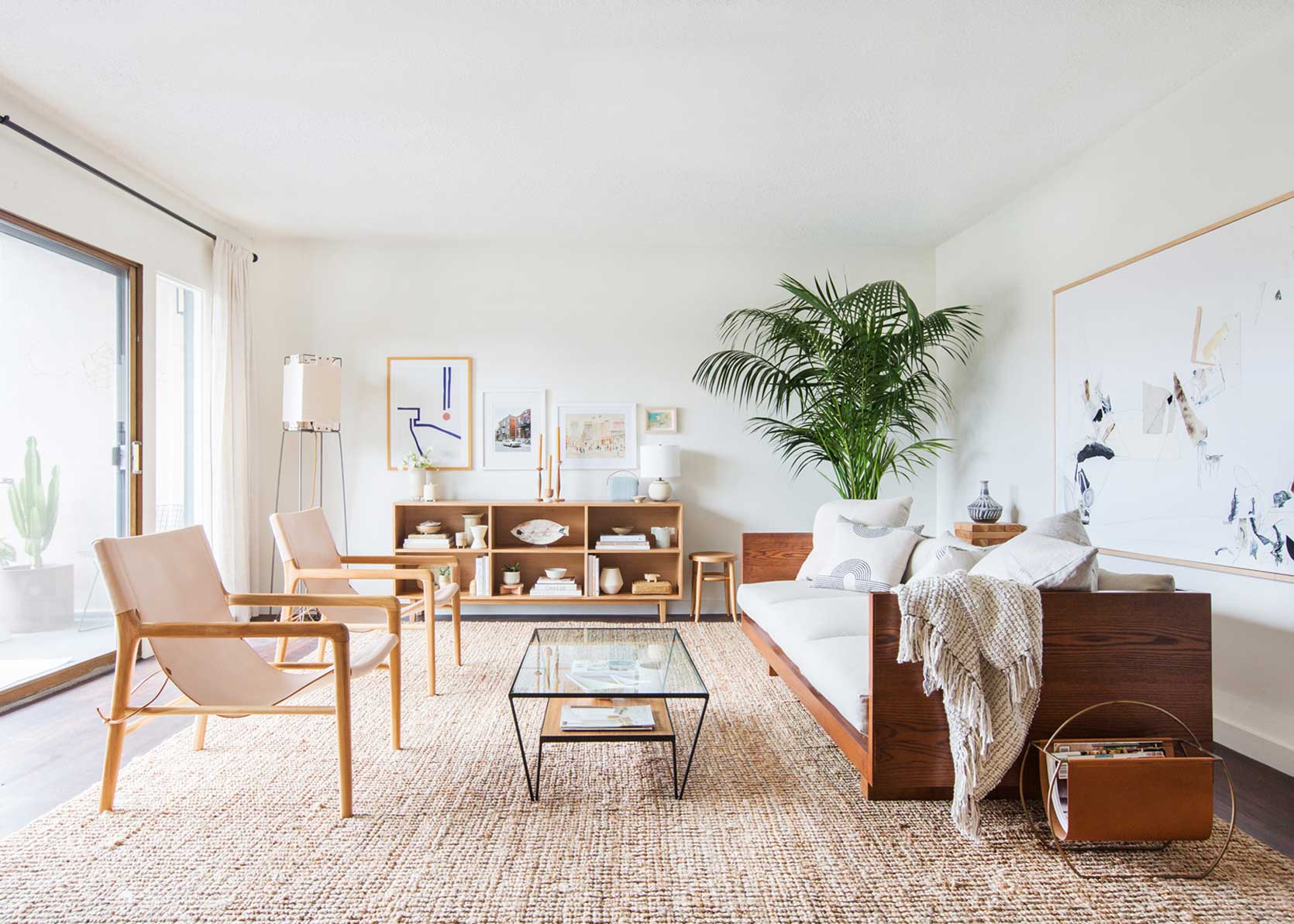
Design Hot Take: Can Designers Stop Trying to Hide Everything Useful?
What came first: The TV or the designer hatred for the TV? Hello friends, and welcome to this week’s installment of Arlyn’s Curmudgeony Design Takedown. Today’s episode? My lack of tolerance for hiding the things in our homes that we need and very regularly use just because they aren’t “aesthetic.” That black remote control? ::Gasp:: The cable modem? MAKE THAT THING INVISIBLE INSIDE A RATTAN BOX STAT! I’m not mad at the desire to have utilitarian things that look nice and surprisingly displayable, but loving design and a beautiful room don’t have to also come with a degree from MacGyver University for how to disguise everything in sight to look like a vintage oil painting or woven basket.
For anyone reading this who is saying, “Arlyn, it’s all about reducing visual clutter,” to that I say: “Yes, I agree, but also, you probably only think that because you read it in an article I wrote a decade ago.” While I get anxiety spikes when things are out of place, cluttered, or untidy, I also prefer my home to work effortlessly without barriers I’ve created for myself in the name of Pretty. Cable management is one thing, but no one should have to sacrifice proper lighting (#TheBigLight) or being able to change the channel because a faux stack of books covering your cable box is blocking the signal.
Who are we doing this all for? Ourselves? Our visitors? We can’t bear to look at a thermostat? A doorbell chime box? Honestly, I think this all hit a fever pitch when images of homes, both by designers and amateurs alike, became a huge part of our everyday vernacular. As someone who has produced hundreds, if not thousands, of luxury home magazine features, I know how much is edited out because cords and light switches are as hated by art directors as they are by designers. This created an aesthetic culture where we all got used to seeing houses without functional things like outlets, and now assume we also need to find a way to Photoshop them out, except in real life. [Side story: I was watching an episode of House Hunters last night, and the featured homebuyer was a woman who made financial empowerment content for social media. She kept saying her home needed to be “aesthetic” and was hyper-focused on white countertops and black hardware because she claims it’s what she needed for her audience to see her as successful. My eyes are only just coming forward from the back of my head.]
Phew! Now that I’ve gotten that off my chest, let’s explore all the “designer disguises” that I find mostly unnecessary, and no one should be pressured into thinking is necessary, either:
Designer Disguise #1: TVs
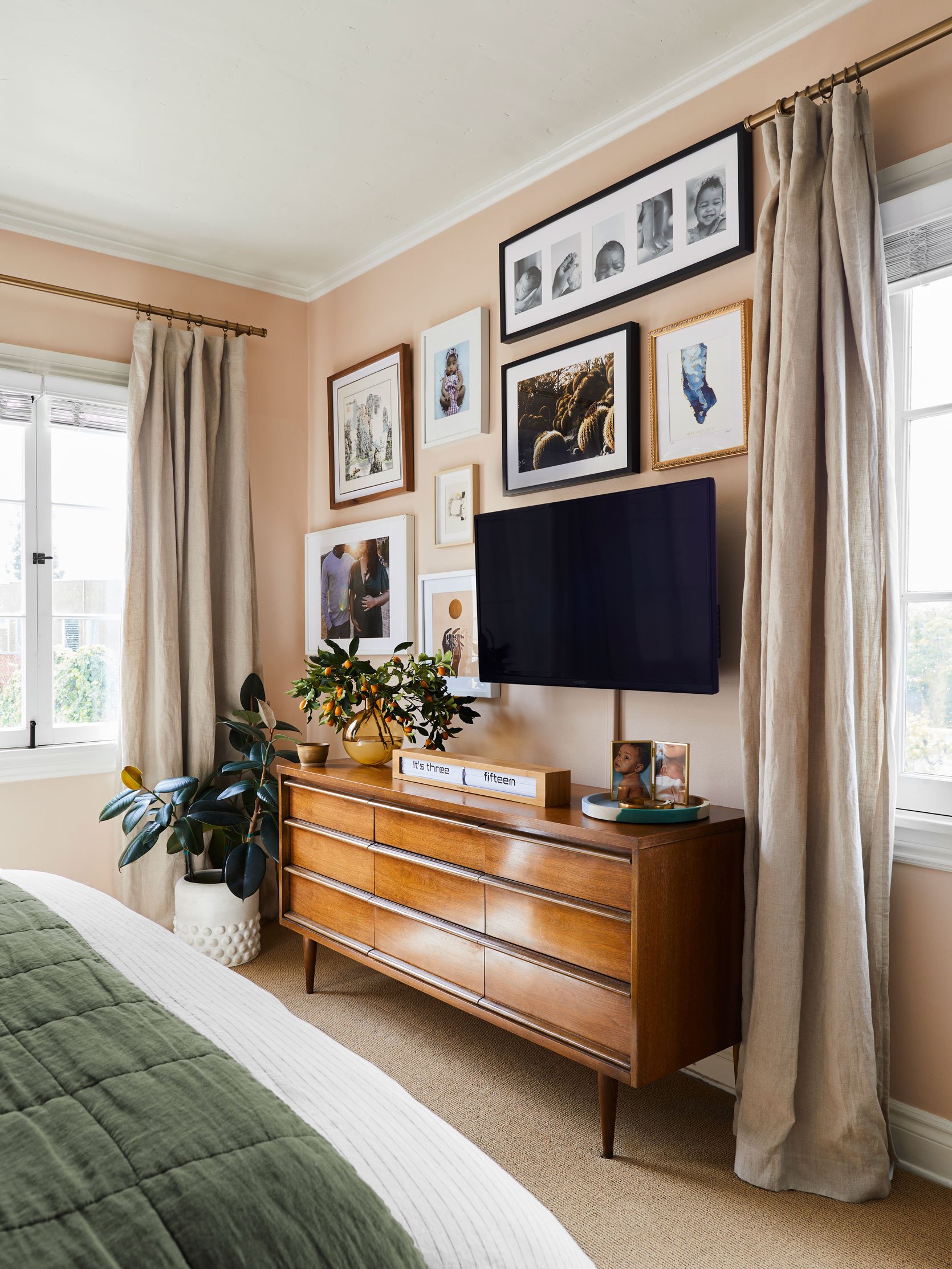
Let’s start with the most polarizing topic: The television. I’ve written on this specific subject in the past and got a ton of opposing feedback. Many agreed with me that a TV is not a thing that needs to be hidden. It’s a part of our lives, and just because it’s a “big black box” doesn’t mean it’s hideous and should be banished. Others brought up some good points about not liking the distraction, and that it’s helpful to put it away behind cabinetry or art or some other concoction when not in use to focus on other things like connecting with loved ones, reading, or conversation. I’ll accept that, because I know that we all have different lifestyles and media tolerances.
But more and more, it just feels like this thing that many of us use daily is some kind of smear on an otherwise beautiful space. Mind you, TVs are smaller and more inconspicuous than ever before. The freestanding furniture-like Sony set that graced my parents’ living room when I was a kid is a far cry from the flat panels of today, and yet we’re obsessed with faking people and ourselves that one simply does not exist in our living rooms.
By far, my most pressing question to all of us here today, whether you’ve thought about hiding your TV or hate the idea, is as follows: Why are we putting so much pressure on ourselves for design/styling perfectionism? I know that our homes are our sanctuaries, and they should make us feel at peace. Visual clutter really can raise our anxiety levels, but are we jumping through performative hoops to make ourselves feel better, or because the Internet slash the design industry, the big “They,” told us we need to hide all these non-decorative things away from the world if we want to be perceived as having good taste, or better yet, chic (the highest podium finish of all the home style qualifies, evidently)?
Designer Disguise #2: Cable Boxes And Remotes
It should come as no surprise that any accoutrement to the hideous television would also need to be shrouded in secrecy, concealed from our delicate eyes. Does the above basket solution look cleaner and tidier than the open crate with cables popping out of it? Yes, sure. A spaghetti-like knot of cords would inspire anyone to find a solution, but the sheer number of videos on the Internet dedicated to cutting holes in baskets and boxes to preserve a pristine shelfie or mantel is dizzying. As long as there isn’t a mess of long cords spiraling from it, collecting dust bunnies, a cable box, or some remotes even just set in a tray on a shelf or atop a book or two is good enough for me.
Designer Disguise #3: Kitchen Appliances
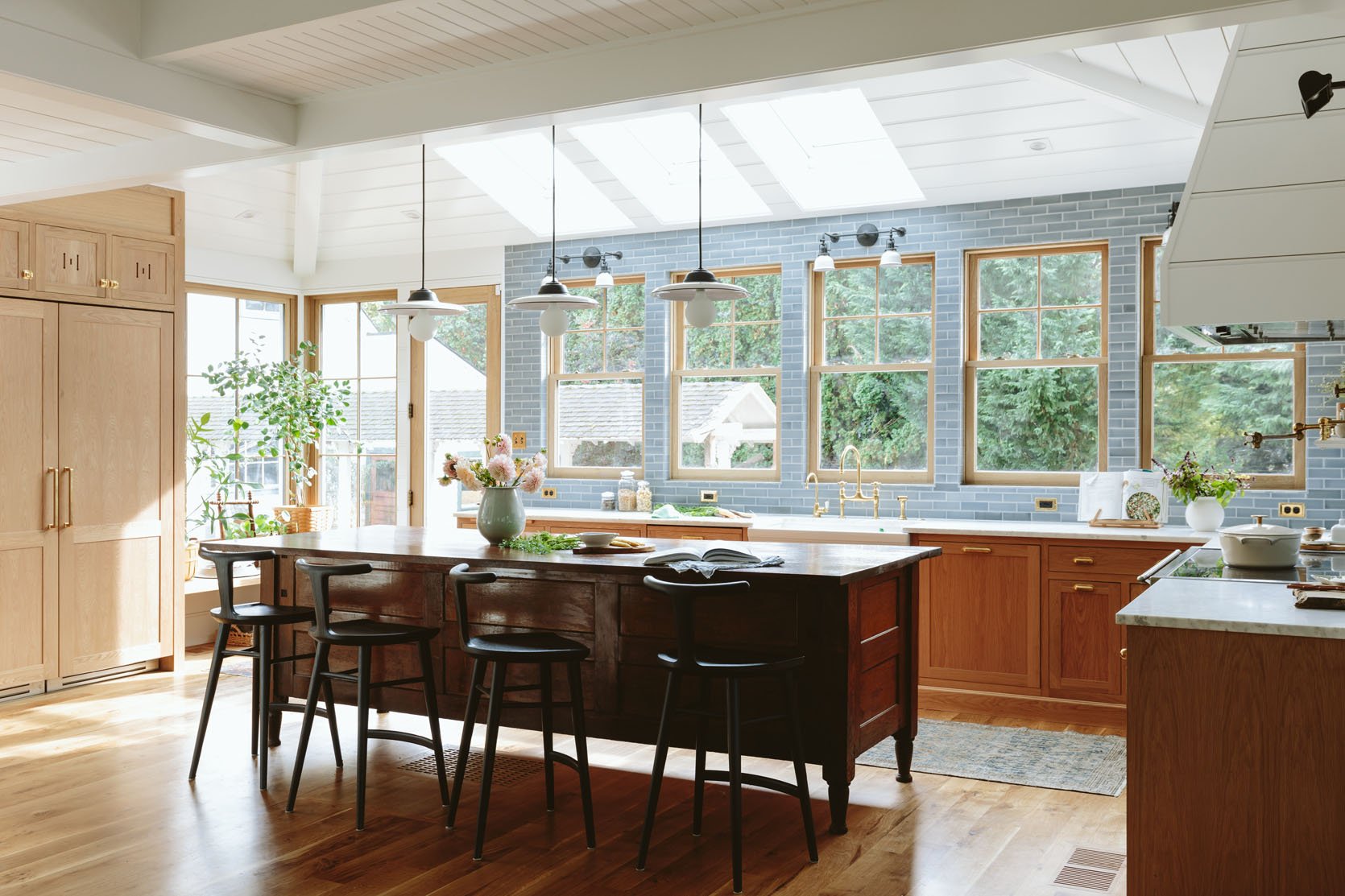
I preface this section with the fact that I very much like the way a seamless kitchen with panel-ready appliances looks. But it’s such a funny thing that someone decided to think up one day. “How do we hide the very things in this space we need the most?” Refrigerator and freezer? Make them guess! Dishwasher? Just open drawers and cabinets until you find it. Obviously, the people who live in a home with this type of kitchen are familiar with and learn where everything is, so none of this is a real concern. However, let’s ponder for a moment the question I keep bringing up: Why are we even doing this?
Designer Disguise #4: Air Vents & Door Chimes
To me, there is a difference between making something look better/sleeker, like good-looking air vents, for instance, and covering up something because you’ve been led to believe it’s ugly. I had this thought recently while reading the newsletter sent out by Apartment Therapy’s Design Director Danielle Blundell. She’s a longtime work peer whom I respect greatly, but in the latest email blast, a reader asked her for her advice on covering her doorbell chime box in her rental. In an attempt to provide a solution, she recommended putting a piece of art on a hinge to cover it up. Sure, that works, but it’s the kind of thing that reminds me of how it has felt to be in a mid- to plus-size body most of my adult life. So much guidance on how to dress your body to essentially cover yourself up as best you can to trick people into thinking you’re somehow thinner than you are, rather than nurturing a culture of acceptance and self-love. “Cover it up!” is the name of the game. Maybe the doorbell chime box is totally fine and can just…remain visible, hm?
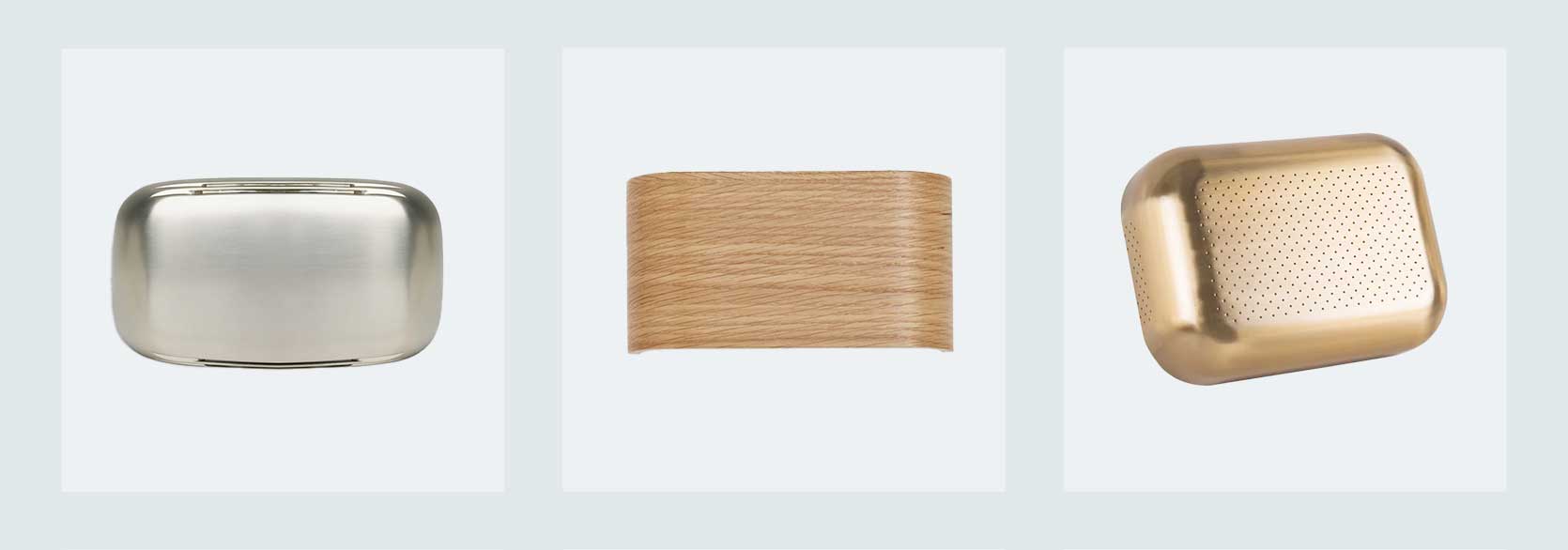
Left to right: Nickel Door Chime | Knock Doorbells Steens Resonator Door Chime | Satin Brass Builder Chime Door Chime
I can get down with a replacement of a cheapo, white plastic chime with something more stately like the above, but hiding it away in shame is just not something I think we should be putting our energies into.
Designer Disguise #5: Any Kind Of Tech Interface
I’ve written so many stories in my past (by request) for other outlets about how to hide your thermostat, your electrical boxes (sure, these are fairly ugly), and all those kinds of things. My answers were always along the lines of what Danielle suggested for the reader’s doorbell chime. It usually involves a hinge and a piece of art. It’s kind of the go-to. Sure, looking at a pretty piece of art is always going to be better than looking at a digital read-out, but for thermostats in particular, I urge you to leave them alone. After some research, it has come to my attention that they do not work as well at recording ambient temperature when the airflow is restricted, as it would be behind a canvas, etc. Meaning, the temperature control is hindered, and that’s a thermostat’s main purpose.
Designer Disguise #6: Cords & Outlets
This one is funny to me. I think a tucked-away outlet inside a drawer is genius as a charging station, but as soon as we get into faux painting (above) or offset drawers that you need to keep open when the outlet is in use, that’s where you lose me. Not to take anything away from an artist or woodworker who could create something like the above—it’s very, very well done—but how scratched up will that be from outlet prongs not exactly meeting their entry points? Perhaps this is a prime example of form over function. There are many beautiful outlet covers out there. Do we really need to be playing hide-and-seek with them?
The same applies to cords. As I’ve mentioned, I’m not against managing cables from becoming tangled messes. If you have the means and the will, running cables behind the walls is totally fine. But I have a secret to share: Your house will never be as cord-free as that professionally photographed and retouched home you admire because many, if not all, of the lamp cords and the like have been deleted from the final image. Let us embrace the reality of our homes, lamp cords and all.
Bonus Designer Disguise #7: Family Photos
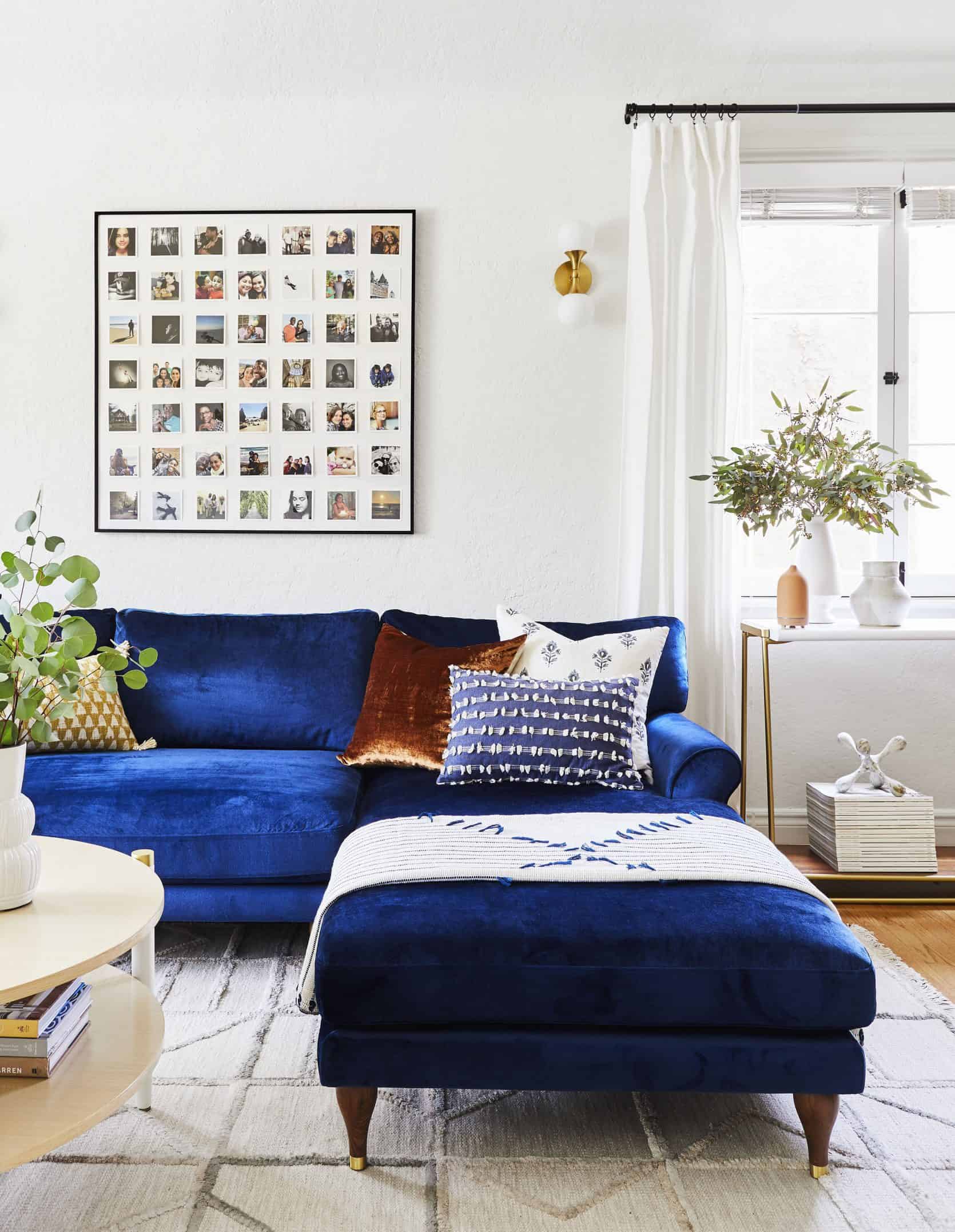
And finally, a little bonus, because I don’t necessarily think this is a “designer” thing more than it is a “styled and photographed magazine home” thing. From experience, many family photos are often removed from houses featured in print for privacy reasons, but do me a favor and take a look at all the gorgeous rooms you have saved in your bookmarks and Pinterest folders. How many of them have family photos? A little corner table with rows of petite frames with abuela, cousins, best friends’ babies? Gallery walls of non-descript or aesthetic abstract art, yes, but hallways full of mismatched frames with 4″x6″ prints are a thing of the past. I want to know who lives in a home when I see it. I want to see their life, their family, their memories. Find a way to display them in a way that feels tidy, if you must, but can we please start decorating with family photos again?
—
Friends, I’ve reached the end of my complaints. I love a beautiful home as much as the next person; after all, I’ve made my living writing about beautiful homes. Don’t bite the hand that feeds you, and all of that. But something I won’t do is just accept a bizarre status quo I don’t perfectly align with to salvage some illusion of having perfect taste and an even more pristine home. Release yourself from the need for flawlessness. Leave your remote on the coffee table. Print out that photo from your family vacation and put it on your console table. Have outlets you can see and use, and not have to hunt for. You deserve it.
Until next time…
Opening Image Credits: Design by Mel Burstin | Photo by Tessa Neustadt | From: Mel’s Living Room Reveal

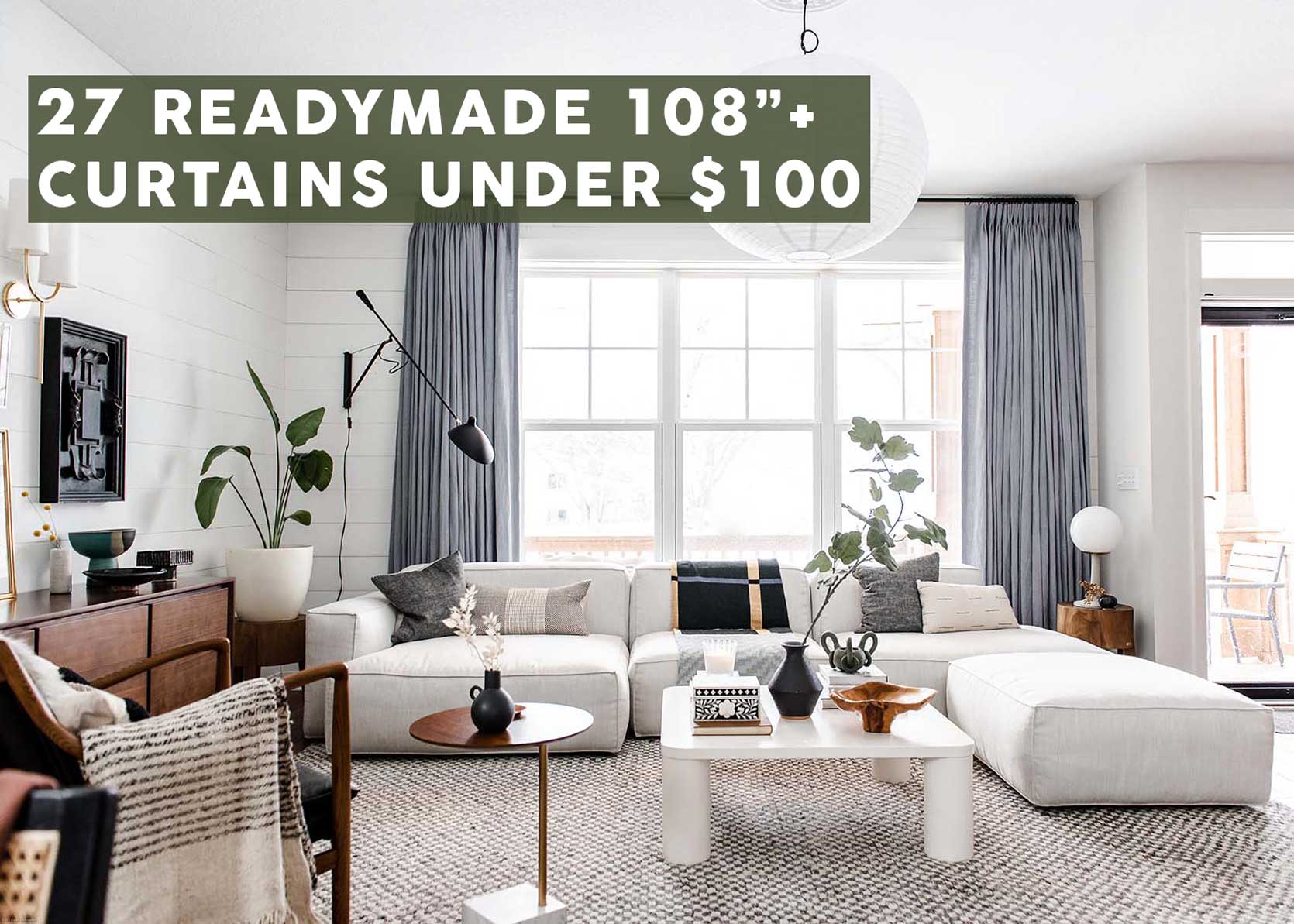

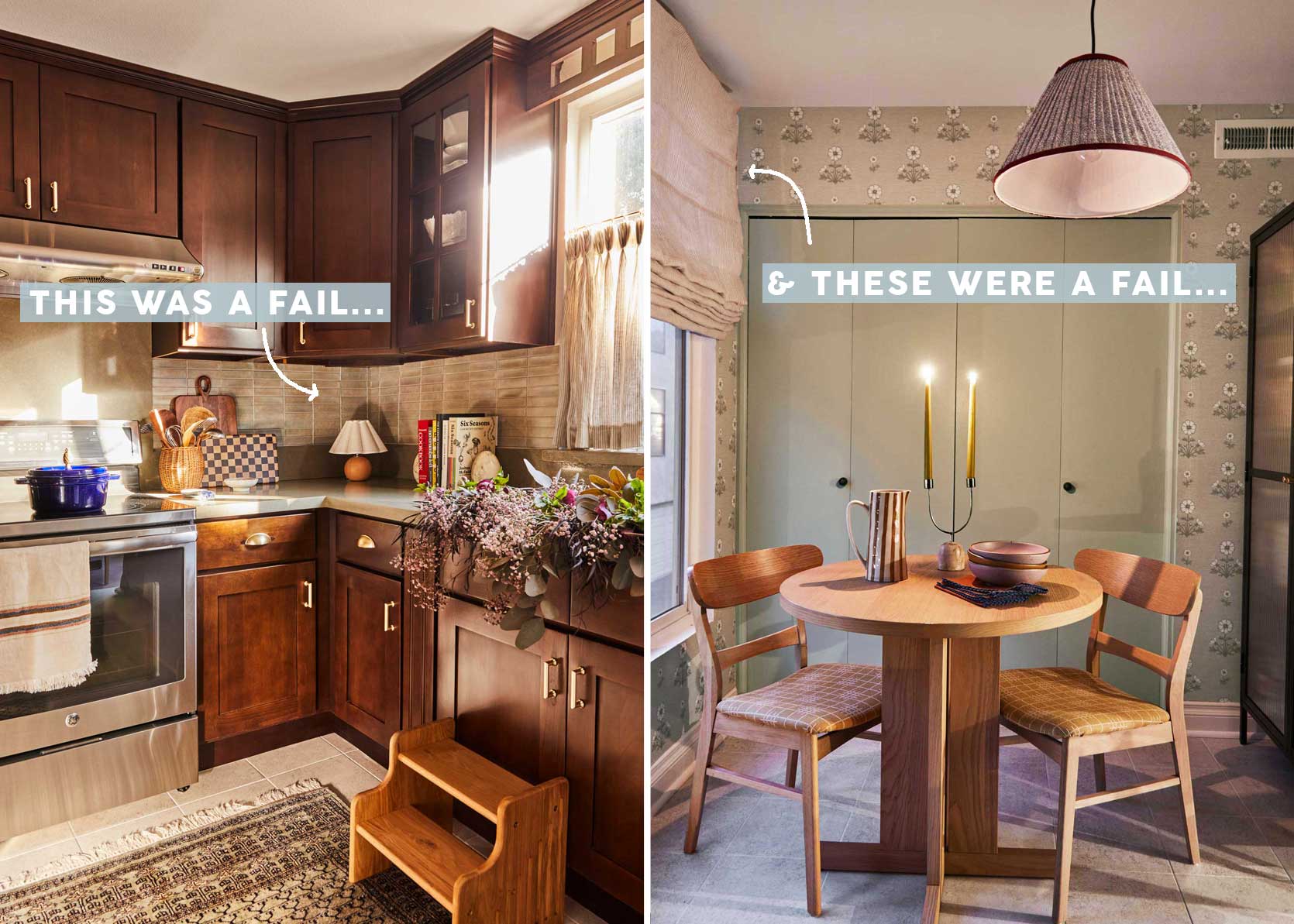
This is SO refreshing!! Thanks for acknowledging the everyday reality of non-magazine spread homes!
I think it goes further than just “people hide things before photo shoots” though: Arlyn seems to be arguing not against masking clutter or pretending tech doesn’t exist, but suggesting that a lot of design efforts currently go into tricking the eye or obfuscating the real use of things.
Design has always had a luxury, aspirational component to it, however. I wonder if all these misguided hacks and trompe l’oeil are not just a race for status but a symptom of the ways in which new tech is disrupting our domestic spaces?
Or perhaps they’re downstream of the country’s housing crisis, with more people stuck renting ill fitted spaces and only empowered to fiddle with cord boxes rather than building a family home that really suits them.
My take, if these things are not meant to be hidden, how about designing them intentionally in the first place. Let’s make charger cables stately rather than tangly little scraps of plastic. Sleek switches. Electrical boxes that are scaled and placed with intent in lines of sight. Routers so pretty you want them on display.
I hate TVs surrounded by art, it makes the art look trivial and emphasises the big black box. I really think the best way to hang a TV is on a dark wall or a unit/built in with a back. Have other bold art in the room that draws the eye elsewhere but don’t wrap it around your TV. The only time the covered up TVs make sense to me is in a home/room where TV is seldom watched.
I think part of why all these things look messy is they look like zero thought has been given to where they sit, so it’s like a room that hasn’t been tidied. If instead they look carefully placed or deliberately featured then they are no longer just clutter.
Yes to all this. I want to add books to this list. On the one hand, some people find their presence to be a mark of educated taste and/or they add texture or whatever. On the other, it’s visual clutter. There’s a fair amount of pressure to prettify book collections and bookcases–punctuating solid rows of books with decorative objects to “give the books breathing room,” arranging books by color, using book covers, turning spines to the wall. That last one is especially amusing but, like family photos, which seem to be “okay” if they’re more artistic or styled artistically or tucked away, there’s definitely pressure to make books visually pleasing, as if it’s not enough to, you know, be a reader with these super practical resources close at hand, organized in a handy way, like alphabetically. I also want to add some other perspectives on the specific items mentioned. I’ve never been a big TV person so, when I got my own apartment, I felt no need for a TV. It was liberating and, yes, the living room looked and functioned better, as a space for socializing, reading, whatever and not centered on passively watching something. If I were to… Read more »
Yay!!!!!! Thank you for this, Maya – as a person with 6,000 + books I could not agree more!!! Thanks for the article Arlyn, once again, you hit the nail on the head!
Yes to an abundance of books— and my rant is against TV designers who style a room with the books’ spines against the wall instead of facing out so you can’t see the titles and authors. Come ON!
Word!
Re: Family photos. Some people like this to remember some special feeling or day they had. E.g. a picture of a moment or day they had before aunt’s passing. Or snapping a photo of something amusing on a special day, (birthday or graduation) your child playing in your favorite spot on Earth. Some people like that kind of reminder, they like to walk by and remember how it felt. It gives them some energy only they understand. And it makes the home special, lived in, and keeps them happy. Those photos don’t have to be obvious or posed. Some people like posed photos, and I guess that’s fine too. Maybe it will be interesting for their younger family to visit and look at the photos on the walls too.
Oh you reminded me of the family photos bullet point. I’m another one who doesn’t feel an urge to display family photos as decor. I actually have photos books for that which I can pull out when I want to reminisce. Little cluttery frames sitting out, or busy mosaics of multiple family images, are neither happy nor enjoyable for me personally.
Yes to the books! Spines to the wall drives me crazy! Books aren’t meant to be neutral. We have a massive bookshelf in our living room and honestly it is such a great conversation starter, not to mention happiness booster to be surrounded by all our book friends 🙃
wow, this is so real. I love it. thank you!!
and I always prefer homes that are real and lived in, in real life and in images. that’s just a preference, but…. I have to say that I think in our political and cultural moment it’s so crucial that we remember to be real and to allow others to be real.
Such a refreshing take! Design should embrace functionality—hiding useful things makes spaces less livable. Loved your insight here.
Yes yes yes!
One of my favorite homes I’ve ever been in was a dated, self-designed home that a couple that filled with seashells and family photos and favorite books and everywhere your eye fell told a piece of their story. It would not be in any magazine and it felt wonderful to be in. A good lesson for me.
That’s my folks’ house, to an extent…. my mom was into “Japandi” back in the 1980s already, so she always had black, white, gray and blond wood decor, but it is also filled with heirlooms and plants, tons of art and books. Even though she has been gone 8 years, and my Dad is barely hanging on to life now, we never reallychanged a thing after her passing, [except a few things that had to be updated like old carpets and cracked bath fixtures and some fresh paint] because their whole life story is encapsulated here.
There’s a great essay in Becca Rothfeld’s All Things are too Small against minimalism you might like. She argues that when people feel out of control politically they take to managing their own little spaces. It seems like this is related.
Preach, Arlyn!! So in agreement on all of this. And I want to add another factor re: TVs … they’ve gotten gigantic. We’ve had 32″ TVs for nearly two decades and recently had to replace ours (cat accident 🙄) – it was so hard to find one at that size! Everywhere we looked the advice was to go way bigger. But TVs don’t need to be huge (as anyone who was alive in the 80’s and 90’s knows). Our 32″ blends in just fine with the speakers and record table on our media console because it’s small.
And echoing the crowd re: books, as well. As former academics, we’ve got thousands of them …. are then in beautiful wood shelves? Yes! But they’re also packed in there and coded largely by topic rather than color. I am a deeply form and reduced visual-clutter person …. but function always needs to be the first concern. This is one of the reasons I love many of the homes featured on The Modern House so much … they look like actual homes designed to be lived in first, and to be beautiful second.
What is The Modern House? Is it a show or something on the web? Im interested
A UK real estate website.
Nothing gives me greater joy than watching beautiful documentaries on our 77” TV. It’s amazing.
Yes! These are all things I don’t want to spend my time and energy on even as I adore beautiful spaces. As a Kardashian once said, Kim, people are dying! Hiding every sign of real life feels counterintuitive to me.
YEEEEEEEEESSSSSSSSSS!
I chuckled so many times while reading – great article. And that “mid- to plus-size body” analogy is excellent. Well done.
I think it’s about individual preference and how “stuff” makes you feel. For me, clutter makes me create more clutter, like a viscous cycle. I also have a relatively small home so I love finding ways to keep ultra organized and not so messy looking more than the design or style of it.
I also found that hiding the TV helps the family as a whole not OVERLY gravitate towards it. This is one of the areas where I definitely put thought into how I wanted to hide it. I bought a vintage MCM highboy dresser and took out the shelving on the top portion to fit the TV. It’s much smaller than the TV armoires of the past. I certainly don’t care if someone else has their TV front and center.
Even with all the systems in place, it’s a home that still gets messy.
I have friends that are way more paired down and organized than me and I am always in awe when I go to their homes and these are homes that aren’t magazine worthy.
I would really love more content that helps us decorate and style and remodel our own homes. I come here for advice, tips, tricks and recommendations. I would like to see more of the things that inspire and help us non-expert make good decisions. I come here for expert help and guidance. Thanks for reading.
My trash pull-out is disguised as two drawers. No one can find it. It’s sort of a fail because I have new people in my kitchen all the time asking me where the trash is but it’s also kind of funny to me because I’m the only one who knows where it is. I’m with you on all of this. I think it’s fine to fuss about vent covers and outlets being cute but also it’s good to remind ourselves from time to time we are being absolutely ridiculous and manic about making our houses perfect.
Yeah I can see it being more confusing because it’s two drawers instead of the traditional one cabinet looking door with handle on top horizontal.
It’s funny, I agree 1000% with the philosophy of this but found that I didn’t agree with all the examples. Pointlessly hidden outlets etc, yes — bring back family photos, hell yes — but I personally hate when a TV dominates the room. Not for purely aesthetic reasons but for life reasons. I WANT it to be hard to mindlessly turn it on, and I also WANT it to be the default for my guests to focus on each other vs something someone just put on in the background and now everyone is sucked in. Similarly, cables and thermostats and other gadgets just make me sad to look at. I don’t think it’s that I’ve been brainwashed, bc I’ve always felt that way even as a little kid. My version of this, though, is other types of regular life clutter. Would I feel more serene and on top of things if I never had a stack of my daughter’s random preschool artwork on the console, or envelopes with the propane bill on the counter, or my non-decanted jar of protein powder sitting by the sink? Idk, maybe, but this is a family home, not a TV set, and I am… Read more »
Oooh… the decanted EVERYTHING in the fridge and pantry. That’s a huge one. I can’t… It’s so pretty, but I just can’t.
I wsh I could vote for this 1000x.
Yes to remembering that my main goal is not to impress but to create a welcoming and comfortable space for myself, my family and guests. When we moved in to our house a couple of years ago I very intentionally started having people over when we hadn’t even unpacked most of the boxes so that I got used to remembering the most important thing is gathering our people, not how the house looks. Perfectionism is a trap. Enjoy creating a beautiful home, avoid the trap of trying to make it magazine-perfect!
Thank you for taking the pressure off!
I also really wish that designers wouldn’t photoshop outlets etc. from their images – sure, it looks aesthetically pleasing but it’s not a true version of the design.
Hahaha!! As a sometime curmudgeon, I appreciate the occasional grumpy list. So many of these things can be way less of an eyesore with a modicum of attention, such as outlets in colors that blend in to their background somewhat. Our TV and remotes are hanging out in the open but backed by medium tone wood walls (we have a lodge house) so they blend in. I definitely have hidden the tangle of TV wires in a box with a hole cut in the back, that’s just a sanity saver IMO! I don’t know what to say about the hidden kitchen appliance thing… perhaps trying to make the kitchen look more like a normal room with furniture/blend into the living space of the home more, since we have tipped to an open/semi open way of living? In real life I’ve only been in a couple homes with hidden appliances and they were definitely high end. You know what I wish existed was smoke detectors in brown and/or black as standard colors. We’re renovating my mom’s new house which is a cottagey ranch with vaulted, planked orangey-pine ceilings. I realized last week that we will have to stick bright white plastic… Read more »
YES!!! I could not agree MORE!! I love design, but i refuse to be a slave to the designer magazine aesthetic. I will not hide my TV or remote. But also, I don’t “style” my coffee table – it has the remote, a couple of coasters, and whatever craft supplies my daughter is currently using; no coffee table books or vases of branches (that will block the view of the TV).
As usual, Arlyn, you’ve made such good points and expressed them so well. It baffled me when people began to emulate hotel design in their own homes. I like homes that look like homes and reflect the personalities that live in them!
I do agree with the commenter who said that we might not feel so compelled to hide many of our useful bits and bobs if they were designed more handsomely, e.g. why not an attractive thermostat?
Lastly, I’m trying to keep in mind that the world is on fire and while obsessing over design details can provide a relatively soothing respite, it can also drain energy and focus from the things that matter most to our country and our world right now.
I’ve been trying to rethink a new couch layout for our living room, but it’s so hard to find examples with a tv, I’ve pretty much given up looking online. The beautiful sitting room with chairs facing a couch just isn’t going to work for us. Yes, I wish we watched less tv, but for now, I just need an arrangement that can hold this family of 5 in a way that (i) looks reasonably good and (ii) doesn’t involve everyone fighting about whether they can see the movie.
My own personal “fail”: all the super tucked-in minimalist composed “bedscapes.”
I make my bed and enjoy a nice throw at the end of the bed, but come on, nobody is tucking their entire duvet in every morning like I see in these shoots for all these low-slung modernist beds.
Also, I have a special pillow for my neck and it’s lumpy (supportive!) but creates an odd number of pillows on the bed and generally ruins the “nobody real sleeps here” vibe that every bedroom shoot has. I try to hide it behind the “cute” linen pillows, but why am I a little defeated each morning by the look of what otherwise is the most comfortable, essential, lifesaving! adaptation I need to sleep well at night? grrr
I have an odd number of pillows on my two-person, queen-sized bed. Just place everything intentionally, and intentional it is!
Thank you for writing this post, and for addressing the hidden elephant in the room! The more design “perfect” rooms we’re presented with, the less content we will feel with everyday living, which leads to more purchases and less contentment.
I do have a Frame TV, which I love. I paid an electrician to hide the cords in the wall. My house is very small, and my living room set up has two couches that face each other with a floor-to-ceiling bookcase at the end of the room. I have a gallery wall behind one couch, and the tv between two windows behind the other couch. The fact that it’s a TV feels less obvious, and IMO helps quell the visual noise in the space.
Pic below–I’m at work, otherwise, I’d take a better pic with the tv in art mode.
I also hide cords wherever I can bc dusty cord tangles make me crazy, and it’s something nice I can do for myself that really only has to be done right once.
Oh My Goodness!! I couldn’t agree more! I think that’s why sites like Apartment Therapy are so successful. Real people’s homes!!
I worked there, and I can attest: Yes, that is exactly why people loved those house tours.
ohmygoodness, I am teary. Thank you for this reminder (b/c I HAVE drank the Koolaid) and the down-to-earth reality check. I absolutely loved this.
Thank you for making me feel better about my highly exposed TV. I live in a very small house. There is really only one spot for the tv that make’s sense for even having a couch. This puts my tv angled in the corner, on top of an antique dresser. I just have to not care that this is where the tv happens to be for me. A Frame TV, with fake art on the screen, will not help make it any less noticeable. But I am able to hide the cable box in a dresser drawer. Now if I could just get someone to come rob my house, of the incredibly ugly sound bar, that my other half just HAD to have for sound. That would make me happier than staring at the tv. Seriously, I will give you my address. Kidding, not kidding. My remote sits in a bowl that I keep photos in. So if I really felt the need to hide it, I would just cover it with photos from the bowl. I’ve never understood not having family photos in a home? Makes no sense at all. My extra bedroom walls are covered in family photos.… Read more »
I like to keep cords neat and subtle, but noticed when we took photos for listing our home that the cords were way more noticeable in photos than in real life. Similar to how your eye glosses over street signs and parking lots in front of an awesome view, but in photos they’re very prominent. I edit out that stuff, not to hide its existence, but to make the photo look like how the room or view looked & felt in real life.
This!!! My sentiments exactly.
I think it’s really dumb to hide the tv. I don’t have a very big tv and I never turn it on before 6pm but I love watching it most nights and doesn’t have such a draw on me that I need to distract myself from seeing it to be able to resist its allure. As someone else said, tvs used to be massive and were front and centre of the living room. They
I love my Frame TV for the bedroom with its rotating art, but my living area has a huge 80″+ TV just out in the open. Its all about context in the space. I would love cooler looking switches, thermostats, and smoke and CO detectors. Cord management is also a must. Love the conversation we are having here today.
Absolutely love all of this!!!
100%
Thanks for the honesty, Arlyn! This seems to be more of a North American thing though? I don’t live there and in Europe the lived-in-and-loved kind of home seems to be more commonly featured. I didn’t even know that people hid thermostats??!! Functionality over form any day!
I agree that we could do with letting go of perfectionism, but also would LOVE to see some images of this mentality in action. Pave the way for the rest of us!
The writer Catherine Newman’s laundry chair in her home tour for cup of Jo was its own small liberation for me. We have a rocker in our room that is right this second and most seconds covered in laundry. Drove me nuts, until I saw that photo (which went, as I recall, un-noted upon by the author. It’s a chair. In a bedroom. Of course there are clothes on it!). Here’s mine:
I loved this! I also want to add that I wish people would leave their trash cans in pictures. I’m all for trash being put away, but I’d love more realistic room showings that show where people’s trash/recycling goes. I read a blog once where the woman acknowledged they normally kept their toilet brush out but put it away for the photo – I say just leave it in! Lets keep being realistic while keeping our spaces intentionally designed.
Agree on trash cans(but they better be nice looking!). Nobody wants to see a toilet brush out in the open, that’s too much. Or an open toilet.
Ditto for a plunger!
Our home is for us to enjoy, not to impress others. So we make our home function for us and what makes us happy. If someone does not like it they dont need to visit. That’s not to say we dont make adjustments to keep little one who visit safe but that’s about all we do for others.
I also dont understand the push to design or decorate you house for a future owner years down the road or the need to update things that function perfectly well because the look this so last year or even last decade. General upkeep is needed but change just for looks is money I would rather use else where.
I put up what I call the “Family Wall” in my newish home. It is an entire wall in the main hallway that I COVERED in 4×6 and 5×7 printed family photos. There are literally over a hundred pictures. It is so in-your-face that it is kind of awesome. Pictures from our wedding, pregnancies, babies, grandparents, cousins, dear friends – god I love the Family Wall <3
Arlyn’s articles are always my fave. Practical, down to earth and thoughtful. Thank you!
Really enjoyed this take! I think it’s so refreshing to see conversations around balancing practicality with beautiful design. After all, good design should make life easier, not just prettier.
On that note, if anyone’s looking for inspiration on how design and functionality can truly go hand in hand, I’d recommend checking out Bowalker. They do an amazing job creating spaces that are both stylish and genuinely livable—great example of how form and function can coexist without compromise.